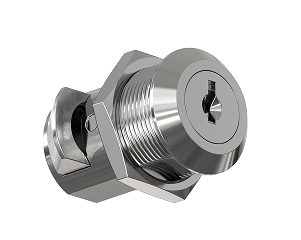When it comes to camlocks, precision is essential. Whether you’re securing a toolbox, locker, or access panel, an incorrect camlock size can lead to installation headaches, poor security, or complete system failure. Most people don’t know how this is actually measured, which is why this guide is here to help.
Understanding how to measure a camlock properly ensures the right fit and optimal performance. It’s the first step in camlock size determination and should not be overlooked. Correct sizing enhances installation efficiency, security, and the overall functionality of your locking system.
Camlocks are compact but critical components in numerous industries. From industrial enclosures to commercial furniture, these locks maintain the safety and integrity of sensitive areas. The smallest miscalculation in measurement can compromise an entire system, hence the importance of this guide.
What is a Camlock?
A camlock (or cam lock) is a type of fastener commonly used in cabinets, drawers, display cases, toolboxes, and enclosures. It uses a rotating cam arm attached to a locking cylinder to secure doors or panels. Unlike traditional locks, camlocks operate with a simple turn of the key or handle, making them ideal for repeated use and easy access.
In both residential and industrial environments, camlocks are valued for their simplicity, security, and adaptability. They are commonly seen in:
- Retail showcases and display cases
- Electrical enclosures
- Medical storage units
- Data center cabinets
- Mailboxes and lockers
- Vending machines
In fact, camlocks are a standard solution for securing glass or acrylic showcases in retail and exhibition settings.
Key Parts That Affect Camlock Measurement
Knowing the parts is crucial for accurate measurement:
- Head/Face: The visible part when installed. It sits flush on the surface and doesn’t contribute to functional depth.
- Barrel: The cylindrical body that goes through the panel. This determines the camlock barrel length.
- Cam Arm: The rotating latch that secures the door or panel when turned.
- Offset: The vertical distance between the center of the cam arm and the end of the lock
- body. This defines the camlock offset measurement.
Each part plays a vital role in ensuring the lock fits the intended space and provides the required
security.

Pro Technician Tip: Where to Measure From
One of the most common errors is measuring from the wrong point. As our technician puts it:
“All camlocks are measured from underneath the head/face of the lock to the inside of the cam.”
This is the industry standard method for accurate sizing. Measuring from the top of the head will give you an inflated and misleading number. Always begin from the base of the head to the internal face of the cam.
This measurement defines how deep the lock sits within the material. It directly affects how the cam arm functions. A lock that’s too short won’t reach the securing point; one that’s too long will protrude and may not install properly.

